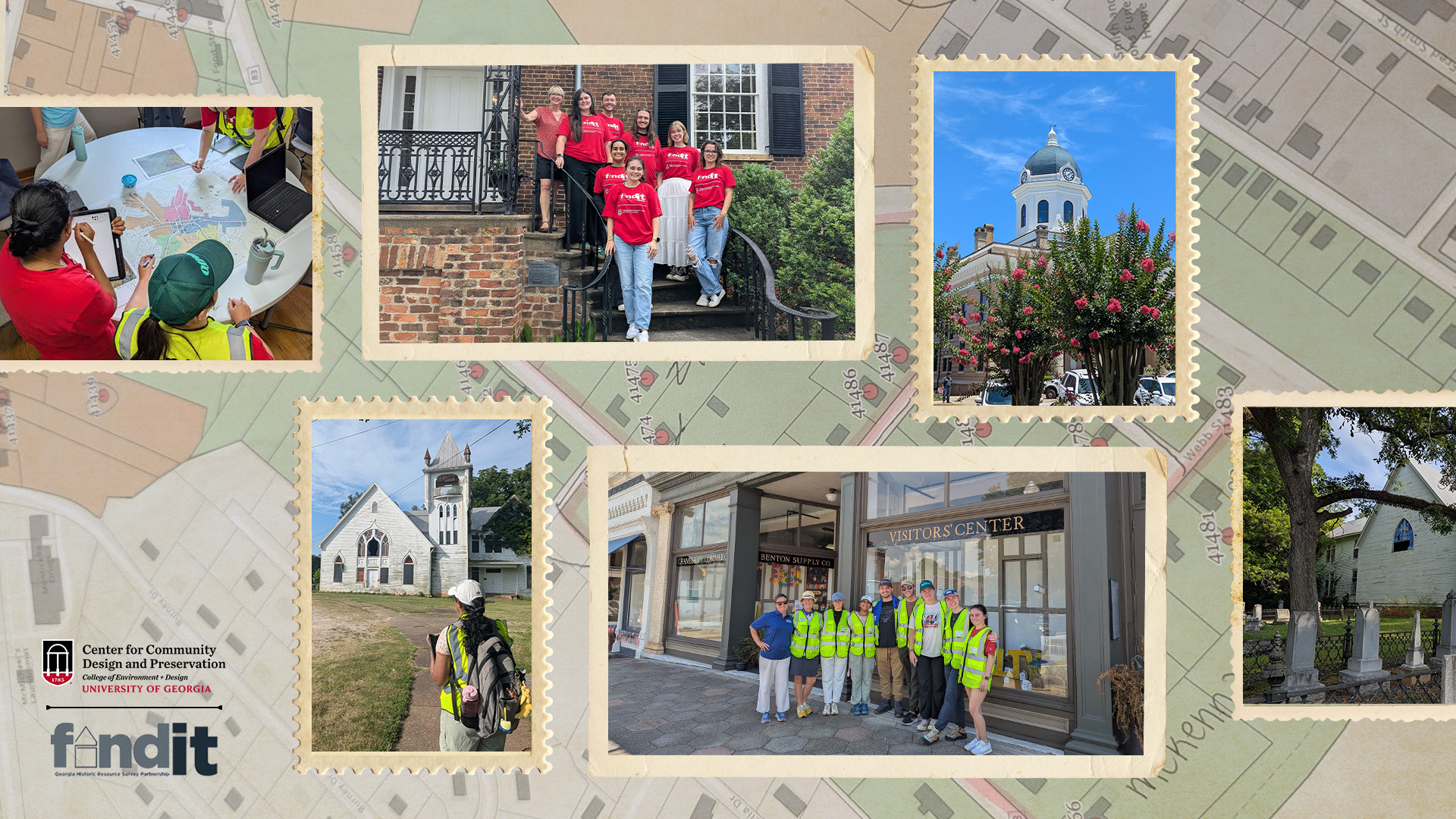This summer, another class of Master of Historic Preservation students entered FindIt, a state-wide cultural resource survey program created to help document historic resources throughout Georgia and facilitate their preservation. The FindIt program, hosted by the CED’s Center for Community Design and Preservation (CCDP), gives students the opportunity to get out of the classroom and explore the historic resources in Georgia. Since 2002, students have been able to learn from professionals and expand their skills.
Each year, the summer internship starts with a two-week training “intensive” led by CCDP Director, Jennifer Lewis. Students spent time taking a deep dive into foundational texts such as “The Ranch House Guide in Georgia” and “Tilling the Earth,” and they tested their identification skills with quizzes over historic architectural types and styles.
During the training period, each student was tasked with going on a “Scavenger Hunt” and creating a presentation with examples of the types and styles they had been learning. With full creative liberty, some students, such as Hayden Dutton, chose to highlight the historic resources in their hometowns.

Clockwise, from top left to bottom right: new crew members play an intense game of FindIt Jeopardy, Zara and Tillman pose with their Ranch House Guides, group photo from VHB visit, students meet with MHP alumni and partners at GDOT, Savanna sits at the big desk after winning Jeopardy, and VHB shadow work (last two images).
These presentations gave students the opportunity to locate and identify historic resources on their own, and it marked their first steps to becoming full-fledged architectural history surveyors. The training period ended with an intense game of Jeopardy. Savanna Davis swept the competition, and she took her rightful place at the largest desk in the FindIt office.
After the training period ended, the FindIt students took part in a shadow week. The students split into two groups– the first group worked with Vanasse Hangen Brustlin (VHB) on a large-scale windshield survey (i.e., observational research from a car) of rural resources.
The second group visited the Georgia Department of Transportation (GDOT). They spent the first day in the Atlanta office learning all about the role historic preservation plays in the construction of the state’s roadways and analyzed urban buildings with professional historians. They were also treated to lunch at the historic landmark diner, The Varsity.
“All of us at GDOT had a great time meeting the FindIt students and sharing with them the work we do,” said Madeline Henerson, GDOT Cultural Resources Section Manager. “We were all very impressed with the results of their mock survey and know they will contribute much to the FindIt program and the field of historic preservation. For one day, we at GDOT got to experience college life again and the thrill of learning. We certainly hope the Findit students had as much a good time as we did!”
The time spent with VHB and GDOT was essential to increasing the students’ understanding of one of the fields that awaits them after graduation.
When asked about FindIt’s role in increasing his understanding of cultural resource management, FindIt surveyor Tillman Norsworthy said, “It increased it in a way unlike anything else I’ve taken through CED, and it did it in a way that was so hands on with professionals that I felt I was part of that world rather than adjacent to it.”
In July, FindIt partnered with the Northeast Georgia Regional Commission (NEGRC) to complete a historic resource survey of the City of Monticello. NEGRC Planning and Government Services employs several CED alumni, including GIS Manager Phillip Jones, MUPD ‘22 and Director Mark Beatty, MEPD ‘17, who worked for FindIt during his time at the CED.
They broke up the project into two phases: resurvey the previously listed historic resources and then survey resources that had not previously been categorized as historic. The NEGRC provided students with sophisticated GIS data that broke the city into sections, and FindIt divided and conquered. The students were able to see in-field examples of historic house types such as Saddlebags, Central Hallway Cottages, and Queen Anne Cottages.
The collaboration proved to be mutually beneficial– NEGRC gained field surveyors, and FindIt learned how to incorporate additional GIS tools into fieldwork.

FindIt workers conduct a historic resource survey of the city of Monticello, GA in collaboration with NEGRC.
They were joined by Dina Bazill of Environmental Corporation of America, a firm that has employed FindIt alumni and wanted to see the program in action. With support from the NEGRC, city residents and officials, FindIt was able to complete the field survey portion of the project in only four days. A total of 400 properties were documented.
“Monticello offered students a living laboratory to apply the historic architectural types and styles they had studied,” said Lewis. “They also saw firsthand how preservation planning benefits a small town, with projects like the former department store transformed into civic offices and the high school’s restoration into an event venue—both first-class examples of adaptive reuse.”
The project in Monticello was yet another way FindIt has been able to expose students to the historic preservation world, made possible with the support of a network of sponsors, partners, and FindIt alumni.
“Working with the FindIt team made this large-scale survey both manageable and efficient, and I was so grateful for their willingness to hit the ground running,” said Jody Graichen, Historic Preservation Planner, NEGRC. “Not only did students get hands-on experience in one of the region’s larger historic districts, but their work will help maintain Monticello’s Certified Local Government status and assist with the Historic Preservation Commission’s design review. This partnership was a huge help to me, and a win for Monticello.”

Structures surveyed in Monticello include a variety of types: (L-R) a Community Store, a Saddlebag Cottage, and a Quonset Hut, likely is a remnant of WWII surplus.
After their Summer internships, students in the FindIt program transition to funded graduate assistantships, where they continue to hone their skills on a variety of applied research projects.
“My FindIt experience taught me much more than I had hoped,” said McKenna White, MHP student and FindIt surveyor. “I am walking away with a better understanding of the job market and expectations of an MHP alumni. I now know that there are points, such as Section 106, that I need to better my knowledge before entering the workforce. I am also taking away a drastically increased understanding of building materials, architectural trends, and ornamentation.”
This not only benefits their professional development, but supports outcomes for the program’s sponsors and partners, including the Georgia Transmission Corporation, the Georgia Department of Transportation, and the State Historic Preservation Office.
“The FindIt students jumped headfirst into the world of cultural resource management and architectural history and are starting this school year with real world experience and knowledge,” said CCDP director Jennifer Lewis. “We are grateful for our network of statewide partners, and I can’t wait to see what’s next for these students.”

